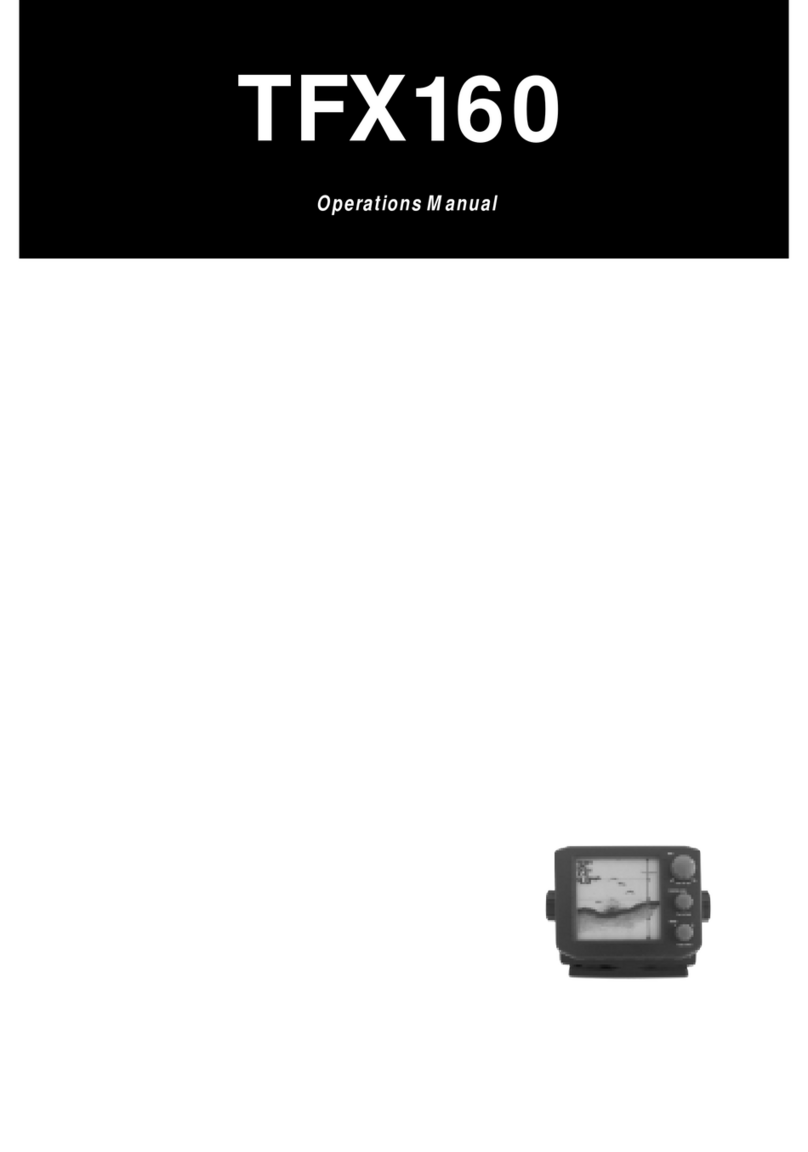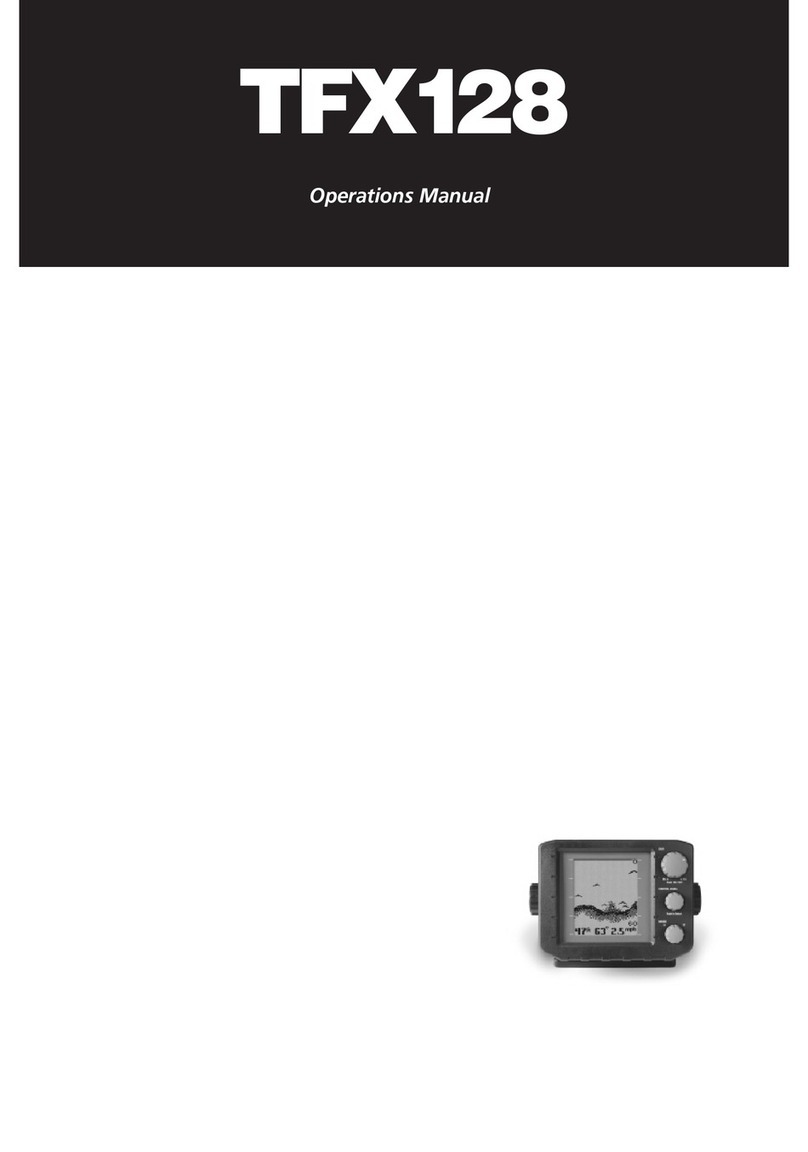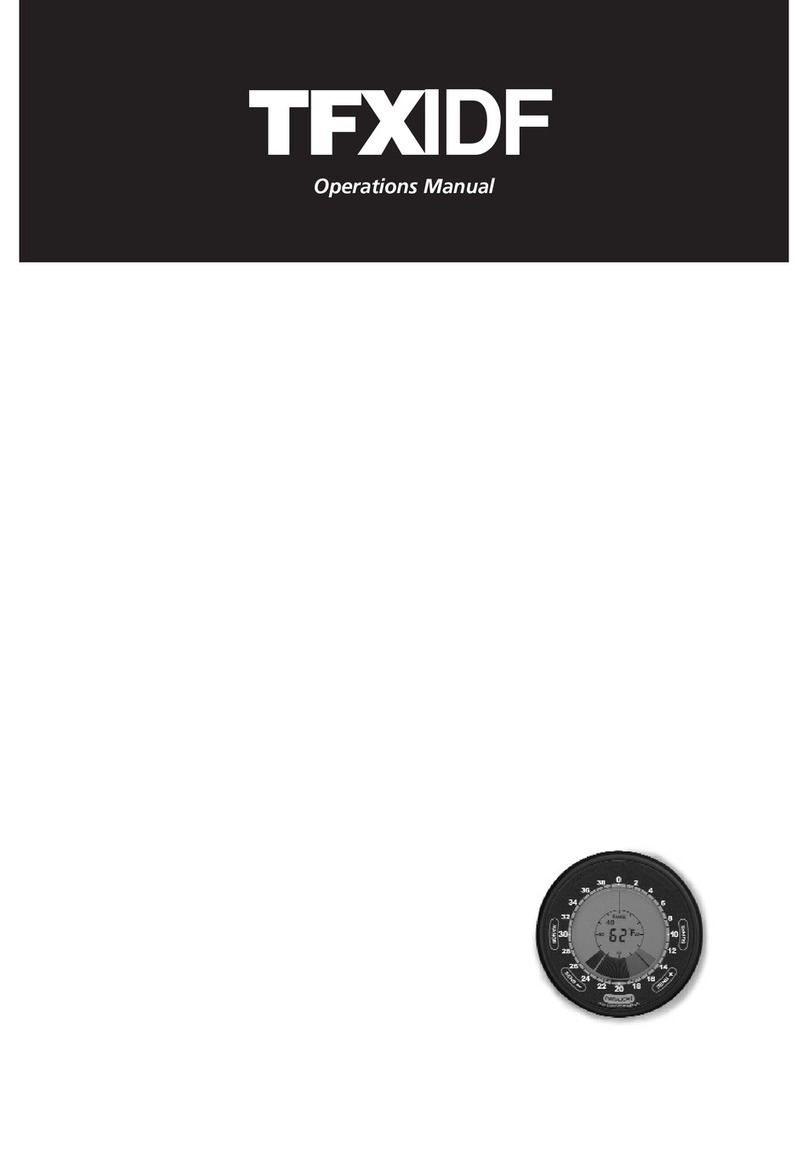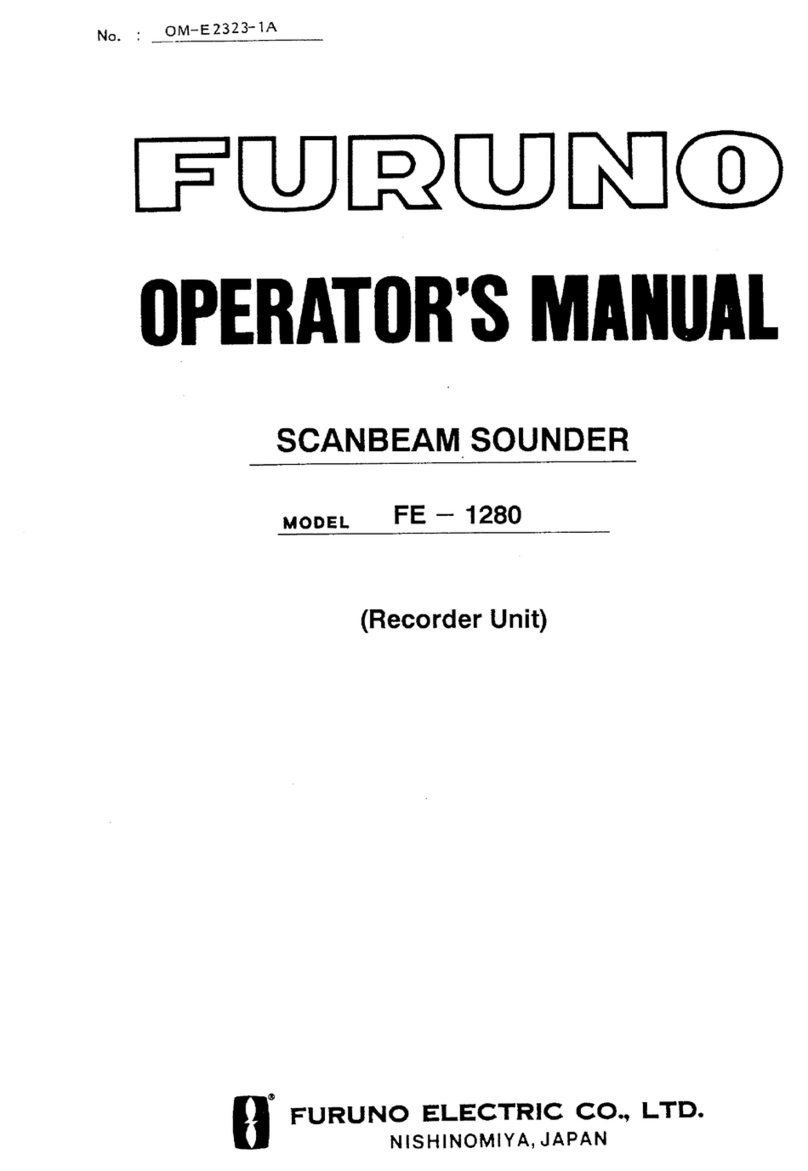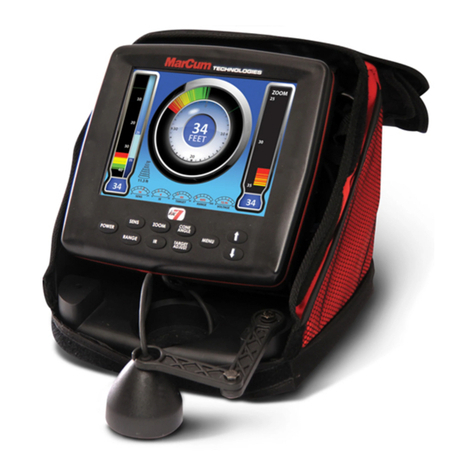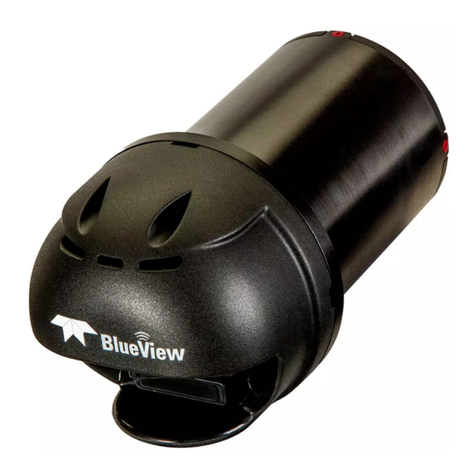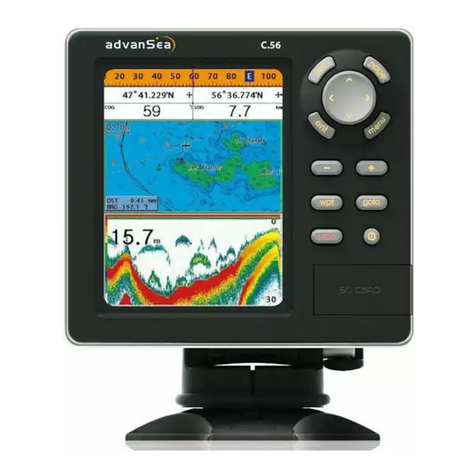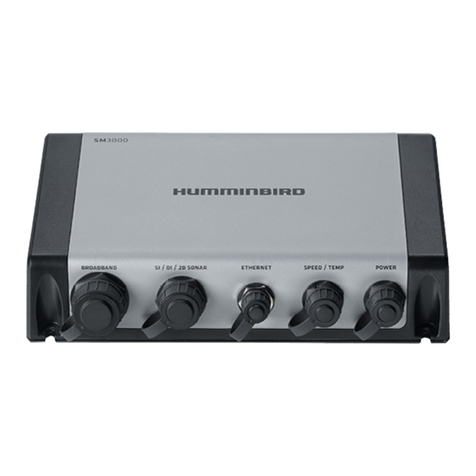Teleflex TFX100ID User manual

TFX100ID
Operations Manual

Thank you for choosing Teleflex Sonar, manufactured by Techsonic Industries,
for your sonar fishfinder and depthsounder. Techsonic has built its reputation
by designing and manufacturing top-quality, thoroughly reliable marine equip-
ment. Techsonic has designed your Teleflex Sonar unit to be trouble free even
in the harshest marine environments.
In the unlikely event that your Teleflex Sonar product does require repairs,
Techsonic offers an exclusive Service Guarantee - free of charge during the first
year after purchase, and available at a reasonable rate after the one-year
period. Complete details are included at the end of this manual.
We encourage you to read this operations manual carefully in order to get full
benefit from all the features and uses of your Teleflex Sonar product. Also, to
register your purchase and help us learn more about you, please fill out the
included warranty registration card
WARNING! This device should not be used as a navigational aid to
prevent collision, grounding, boat damage, or personal injury. When
the boat is moving, water depth may change too quickly to allow
time for you to react. Always operate the boat at very slow speeds if
you suspect shallow water or submerged objects.
THANK YOU
WARNING:
Dis-assembly and repair of this electronic unit should only be performed by authorized service
personnel. Any modification of the serial number or attempt to repair the original equipment or accessories by
unauthorized individuals will void the warranty. Handling and/or opening this unit may result in exposure to
lead, in the form of solder.
WARNING: This product contains lead, a chemical known to the State of California to cause
cancer and birth defects and other reproductive harm.

TABLE OF CONTENTS
Section One: USING the 100ID Series . . . . . . . . . . . . . . . . . . . . . . . . . .2
How Sonar works . . . . . . . . . . . . . . . . . . . . . . . . . . . . . . . . . . . . . . . . . . . .2
Introduction . . . . . . . . . . . . . . . . . . . . . . . . . . . . . . . . . . . . . . . . . . . . . . . .3
Simulator Operation . . . . . . . . . . . . . . . . . . . . . . . . . . . . . . . . . . . . . . . . . .3
Using Depth Offset . . . . . . . . . . . . . . . . . . . . . . . . . . . . . . . . . . . . . . . . . . .3
What You See On-Screen . . . . . . . . . . . . . . . . . . . . . . . . . . . . . . . . . . . . . .5
Control Functions . . . . . . . . . . . . . . . . . . . . . . . . . . . . . . . . . . . . . . . . . . . .8
Menu Functions . . . . . . . . . . . . . . . . . . . . . . . . . . . . . . . . . . . . . . . . . . . . .9
Section Two: Maintenance and Warranty . . . . . . . . . . . . . . . . . . . . .18
Maintenance . . . . . . . . . . . . . . . . . . . . . . . . . . . . . . . . . . . . . . . . . . . . . .18
Troubleshooting . . . . . . . . . . . . . . . . . . . . . . . . . . . . . . . . . . . . . . . . . .19
One Year Warranty . . . . . . . . . . . . . . . . . . . . . . . . . . . . . . . . . . . . . . . . .20
Service Policy . . . . . . . . . . . . . . . . . . . . . . . . . . . . . . . . . . . . . . . . . . . . . .21
Customer Support . . . . . . . . . . . . . . . . . . . . . . . . . . . . . . . . . . . . . . . . . .22
Specifications . . . . . . . . . . . . . . . . . . . . . . . . . . . . . . . . . . . . . . . . . . . . . .23
Rev 10420E

2
USING THE 100ID SERIES
HOW SONAR WORKS
HOW SONAR WORKS
Your Teleflex Sonar unit uses sonar
to locate and define underwater
objects, define the bottom terrain, as
well as determine distance.
Sonar technology is based on sound
waves. Your sonar unit sends out a
sound wave signal. With this signal it
determines distance by measuring
the time between the transmission
of the sound wave and when the
sound wave is reflected off an
object. Your sonar uses the reflected
signal to interpret location, size and
composition of an object.
Sonar is very fast. A sound wave can travel from the surface to a depth of
600' (185m) and back again in less than ¹⁄₄ of a second. It is unlikely that
your boat can "outrun" this sonar signal.
The 100ID series is a single frequency, single beam unit, and generates a 16°
symmetrical cone of sonar coverage at 200kHz. The 16° coverage shows
excellent bottom detail with a greater depth capability than wider beams.
The sonar return shows the most current information at the right of the
screen and draws a history of the information as it scrolls across to the left.
Actual depth capability depends on factors such as bottom hardness,
water conditions, and transducer installation. Units will typically read to
deeper depths in fresh water than in salt water.

3
INTRODUCTION
The 100ID series is easy to use. Simply press the POWER button, and the
unit will automatically locate the bottom, adjust the depth range and
sensitivity to an appropriate level, and draw a picture of the terrain
beneath your boat. If POWER is the only button you press, you will bene-
fit from the advanced automatic bottom tracking capability of the unit.
However, if you choose to experiment with the many features and
controls the 100ID offers, you can customize the presentation of informa-
tion to suit your particular needs. The 100ID offers a wide variety of
settings and types of display, to satisfy any sonar need.
SIMULATOR OPERATION
The 100ID contains a simulator which allows you to use the unit as if you
were on the water. This simulator is invaluable for learning how to oper-
ate the many features of the 100ID unit.
With the unit turned off, press and hold POWER until you hear a continu-
ous chirp. This initiates the simulator operation. Your 100ID will simulate
all functions as if it were actually on the water.
To exit the simulator, press POWER to turn the unit off. Pressing POWER
again will power-up the unit for normal operation.
When in simulator operation, the
100ID unit will respond to control
inputs as if it were in actual opera-
tion, so feel free to experiment with
the many features and functions to
customize the 100ID unit for your
particular application.
USING DEPTH OFFSET
Depth Offset adjusts the digital
depth readout to show distances
approximated from either the water-
line, or the lowest point of the hull.
This is accomplished by selecting an
USING THE 100ID SERIES
INTRODUCTION
Depth Offset at Zero

USING THE 100ID SERIES
USING DEPTH OFFSET
offset value at start up which the unit
adds or subtracts to the sonar depth
measured from the location of the
transducer.
When you turn on the 100ID, the
Depth Offset screen will appear for
several seconds to allow time to select
your depth offset. Use the UP or
DOWN arrows to adjust the setting to
yield the desired depth measurement
as follows.
Selecting a positive number equal to
the vertical distance between the trans-
ducer and waterline provides a depth
reading approximated from the water-
line. This “true depth”is useful for
comparing to depth soundings plotted
on navigation charts. Use caution when
operating in suspected shallow water
as many factors such as tide and waves
can effect the actual depth.
Selecting a negative number equal to
the vertical distance between the
transducer and lowest point of the hull
will give depth readouts from the
bottom of the hull, or keel.
Leaving the depth offset at zero will
have no effect on the depth readout as
measured from the transducer.
Depth Offset has a range of adjust-
ment of -10 to +10 feet, and must be
set at start-up each time the unit is powered on.
Depth Offset to Waterline
Depth Offset to Keel
4

5
USING THE 100ID SERIES
WHAT YOU SEE ON-SCREEN
WHAT YOU SEE ON-SCREEN
The first thing you may notice about the 100ID unit is the high-resolution
LCD display. The LCD display uses super-twist technology, for maximum
viewability and is ruggedized for tough shock and vibration endurance.
The display can operate at temperatures more extreme than you are likely
to encounter.
There are two basic screen layouts for the 100ID. Figure A shows the
default screen layout which does not include speed and temperature read-
ings. If you have purchased the Speed and Temperature accessory and it is
installed, the screen layout will be slightly different as shown in Figure B.
The number of vertical pixels (picture elements or dots) in a given depth
range determines the display resolution, or ability to differentiate targets
close to the bottom or other targets. The 100ID is capable of distinguish-
ing between targets only 6" apart, and show fish within 6" of the bottom.
Figure A
Zero Line
Thermocline
Bottom Terrain
Lower Range Limit
Sensitivity Setting
Depth
Range Control Setting
Bottom Alarm Indicator
Fish Alarm Indicator
Upper Range Limit
ID+ Fish Depth Fish Symbol

6
On all screens the horizontal
line at the top of the display is
the “Zero”line. This repre-
sents the surface of the water.
The “Zero”line will always
have a gap which moves as
the screen updates. This gap
lets you know that the display
is updating even if the bottom
terrain remains the same or is
not visible on the selected
depth range. The farthest
right column of information is
the most recent information,
and it shows what is directly
under your boat.
At power-up, the 100ID
locates the bottom and
adjusts the depth range to a
setting most appropriate for that
depth. The bottom will be usually
shown about ²⁄₃ of the way down
the display. The Structure ID™
depiction of the bottom will vary in
appearance depending on the
bottom terrain. If the bottom is
very hard and smooth, the bottom
depiction will be narrow and
dense. If the bottom is mud or soft
sand, the bottom depiction will be
thick and less dense. This indicates
that much of the sonar signal is
absorbed by the soft bottom. If the
bottom is rugged and varying, such
as a rocky bottom, the depiction
will be textured and vary in density.
Structure, such as submerged trees
or brush, or other objects are
clearly displayed above the solid bottom return, in varying densities of
USING THE 100ID SERIES
WHAT YOU SEE ON-SCREEN
Figure B
Boat Speed
Water Temperature
Most current information
Hard Smooth Bottom

7
pixelization. This bottom depiction is
useful in locating structure, by comparing
relative density as well as depth.
The transmitted sonar signal travels down-
ward, and is reflected back toward the
surface by the bottom or other objects for
display on-screen. The signal does not stop
there - it is reflected downward again by the
surface of the water, and a weak “second
return”is usually visible if the depth range is
sufficient to see it. A second return is shown
in the figure below. Some users use this
second return as an indicator when setting
the sensitivity bias.
If a target is detected between the surface
and the bottom, it is displayed as a fish
symbol. Depending on the strength of the
signal reflected from the object, one of
three different size symbols is used. These
reflected signals are “normalized”for depth,
so that a small fish does not appear to be a
large fish if it is close to the boat.
Since some species of fish tend to be better
reflectors of sonar than others, the strength
of return is not always an accurate indicator of
fish size, however, typically the larger the
fish, the larger the signal return.
USING THE 100ID SERIES
WHAT YOU SEE ON-SCREEN
Soft Mud
Rocky Bottom
Second Return

8
CONTROL FUNCTIONS
The 100ID unit uses only four buttons to control all functions. When any
button is pressed, an audible “chirp”will verify the control input.
POWER, as previously discussed, powers the 100ID for
normal operation. Also, if the unit is powered off, press and
hold POWER until you hear a continuous “chirp”to enable
simulator operation as discussed in “Simulator Operation.”
Pressing POWER when the unit is in normal or simulator
operation will power the unit off.
MENU brings a menu on-screen for adjustment, or if a menu
is already present, the next menu in sequence will appear.
Menus will go off-screen and normal operation will resume
after a short period of time.
UP arrow selects the next larger or next sequential adjust-
ment within the menu. Holding an Arrow button down will
cause the unit to continue to make the adjustment, until a
limit is reached, and the limit alarm sounds.
DOWN arrow selects the next smaller adjustment within
the menu.
All menus use the same general layout as shown in the sample menu. The
heading of the menu is at the top. The area at the bottom is controlled by
the UP and DOWN arrows.
USING THE 100ID SERIES
CONTROL FUNCTIONS
Menu Heading
Arrow Key
Functions

9
MENU FUNCTIONS
The following section explains each menu in
detail, and how these adjustments can be
used to obtain the maximum information
from the sonar returns.
SENSITIVITY. As the 100ID receives returned
signals, the sensitivity of the receiver is
adjusted automatically based on a number of
factors such as the depth of the water, and
the signal clarity. In murky water, full of
debris, the 100ID will select a lower sensitivity
setting. In clear water, where there is little
debris to reflect the sonar signal, the sensitivity
is set higher.
The Sensitivity menu allows you to “bias”this
automatic setting up or down based on
personal preference.
You can select a bias of +5 to -5, for 11 differ-
ent bias settings. A bias setting of “0”has no
effect on the automatic function. A +3 setting
selects a sensitivity setting three steps higher
than the unit would normally select, so even
the smallest returns are displayed on-screen.
A setting of -2 sets the sensitivity two steps
below what the unit would normally select,
so only the largest targets or other returns
are displayed.
USING THE 100ID SERIES
MENU FUNCTIONS
Sensitivity bias of -2
Sensitivity bias of +3

10
RANGE. 100ID adjusts the depth
range automatically, so the bottom
return is displayed at the bottom ¹⁄₃ of
the display. This leaves the top ²⁄₃ to
display anything between the surface
and the bottom. As your boat moves
over deeper or shallower water, the
unit adjusts the depth range of the
display to keep the bottom return in
the same general area on the screen.
However, you may choose to control
this range adjustment manually. By
pressing the UP and DOWN arrow
buttons you can select manual opera-
tion, meaning the unit will no longer
adjust the depth range automatically.
The depth range selected is also
controlled by the UP and DOWN arrow buttons. Ranges of 0 - 15,
30, 60, 120, 180, 240, 360, 480, and 600 feet can be selected. An
on-screen icon indicates whether the unit is in “AUTO”(automatic)
or “MNL”(manual) range control.
If you alter the depth range,
Manual operation is auto-
matically selected. This
feature is valuable if you are
only interested in targets
near the surface. The 100ID
will always display the digital
depth of the water, regard-
less of whether the bottom
is shown on the selected
depth range.
USING THE 100ID SERIES
MENU FUNCTIONS
Auto Range Control Indicator
Manual Range Control

11
ZOOM. Another form of range
control is Zoom. Zoom allows
selection of various ranges for full
screen viewing. By using the
display to view a smaller area, the
effective display resolution is
increased, and the units ability to
separate targets close together is
enhanced.
The zoom range is determined by
the depth range in use when
Zoom is enabled. In shallow water,
when the 15' or 30' depth range is
used, the zoom range will be 15'.
If the 60' or 120' depth range is in
use, the zoom range will be 15', if
a 180' to 480' depth range is used,
the zoom range will be 30', and if
the 600' range is in use, the zoom
range will be 60'.
Pressing the UP or DOWN arrow
button enables zoom and adjusts
the zoom ‘window’to the desired
depth. The upper and lower limits
are shown on-screen and the digi-
tal depth readout will continue to
track the bottom even when
Zoom is enabled.
To disable Zoom press the UP
arrow button until Zoom turns off.
USING THE 100ID SERIES
MENU FUNCTIONS
Zoom Window Indicator With
current top and bottom ranges
Depth Range
Auto Range Indicator

12
BOTTOM ALARM. The 100ID contains
an audible alarm to warn you of shal-
low water depths. This alarm is
adjustable from 2' to 99' of depth.
To enable the alarm, simply adjust
the alarm depth using the UP and
DOWN arrow buttons. When the
depth of the water beneath your
boat is equal to or less than the
selected alarm depth, a continuous
alarm will sound.
To disable the alarm, either move to
deeper water, or use the UP button
to turn the alarm off.
FISH ALARM. The Fish Alarm alerts
you to the presence of fish, or other
targets not attached to the bottom,
in the water beneath your boat. The
Fish Alarm has 3 different settings
which correspond to the 3 different
size fish targets shown on-screen.
To enable Fish Alarm, use the UP
and DOWN arrow buttons to adjust
the size return you want to be
alerted to: large fish only, large and
medium size fish, or all fish. To
disable the alarm use the UP button
to return to the off position.
USING THE 100ID SERIES
MENU FUNCTIONS
Bottom Alarm “ON” Indicator
Fish Alarm “On” Indicator

13
Remember that it is impossible for sonar to determine if a signal return is a
fish or some other type of object or suspended debris. Any object not
connected to the bottom is normally a fish and is portrayed as a fish symbol.
The strength of the reflected sonar signal from a target is a good indicator
of the size of the target, and the fish symbol displayed represents the
strength of the signal reflected from it.
ID. ID is the automatic identification of
target returns based on the strength of
the returned signal and other factors.
Three options are available: ID “On”
displays targets as one of three differ-
ent size fish symbols.
“ID+”, the default setting, provides
more information about the location
of the target by attaching depth
“strings”showing the digital depth of
the target. When there are numerous
targets on-screen, not every target
depth is shown, to avoid excessive
clutter on-screen.
USING THE 100ID SERIES
MENU FUNCTIONS
ID+ Fish Depth
ID “ON”

14
ID “Off”disables the units interpreta-
tion of targets, and displays the “raw”
sonar information as it is received.
Advanced users may prefer this type of
presentation, so they can make there
own interpretation from the informa-
tion displayed.
UNITS.The Units menu is used to
select the units of measure for the
digital speed readout. Two units of
measure are available: miles per hour
(MPH) or nautical miles per hour (KTS).
The selected unit of measure also
affects the distance readout in the
Triplog menu. When MPH is selected
distance readouts will be statute miles
(MI); when KTS is selected the read-
outs will be in nautical miles (NM).
Note: The optional Speed &
Temperature accessory must be
connected for the Units menu to
be available.
USING THE 100ID SERIES
MENU FUNCTIONS
ID “OFF”: Raw Sonar

15
TRIPLOG.Triplog provides a
time/distance calculation, based
on input from the optional speed
accessory. The timer is started
when the unit is first powered on,
and distance information is
collected to provide elapsed
distance since power-up, and the
average speed. To enable the
Triplog display, press the UP OR
DOWN arrow button.
Triplog can be reset at any time by
pressing the UP OR DOWN arrow
button. Press MENU to return to
the normal screen.
Note: The optional Speed &
Temperature accessory must
be connected for the Triplog
menu to be available.
USING THE 100ID SERIES
MENU FUNCTIONS
Triplog On

16
SPEED-DEPTH.The Speed-Depth
menu controls the display of a full
screen digital readout for boat
speed and depth.
To view the Speed-Depth screen,
use the UP or DOWN arrow to
show the full screen display. The
current boat speed is displayed at
the top the screen, and current
depth at the bottom. At any time
you can return to the normal sonar
view by pressing the MENU
button.
Note: The optional Speed &
Temperature accessory must
be connected for the Speed-
Depth menu to be available.
USING THE 100ID SERIES
MENU FUNCTIONS
Speed-Depth Screen

17
SPEED TIMER.The Speed-Timer menu
controls the display of a full screen
digital readout for boat speed and a
countdown timer.
To display the Speed-Timer screen,
use the UP or DOWN arrow to show
the full screen display. Current boat
speed is displayed at top, and the
countdown timer at the bottom.
To set the countdown timer, use the
UP arrow to select one of the four
countdown presets: 0, 5, 10, or 15
minutes. The current countdown
timer setting is displayed above the
digital timer readout. Once you select
a setting other than zero minutes, the
countdown timer is activated and will
alarm when the timer reaches zero.
After alarming the timer will begin to
count up. Restart the timer by using
the DOWN arrow.
At any time you can return to
normal sonar operation by pressing
the MENU button.
Note: The optional Speed &
Temperature accessory
must be connected for the
Speed-Timer menu to be
available.
USING THE 100ID SERIES
MENU FUNCTIONS
Speed-Timer Screen

18
MAINTENANCE
Your Teleflex 100ID depthsounder is designed to provide you with years of
trouble-free operation with virtually no maintenance. Follow the simple
procedures below to ensure that your 100ID continues to deliver top perfor-
mance.
If the unit comes into contact with salt spray, simply wipe the affected
surfaces with a cloth dampened in fresh water.
When cleaning the LCD protective lens, use a chamois and non-abrasive,
mild cleaner. Do not wipe while dirt or grease is on the lens. Be careful to
avoid scratching the lens.
If your boat remains in the water for long periods of time, algae and other
marine growth can reduce the effectiveness of an externally mounted trans-
ducer. Periodically clean the face of the transducer with liquid detergent.
Pivoting the transducer up in the bracket may allow better access for inspec-
tion or cleaning.
If your boat remains out of the water for a long period of time, it may take
some time to wet the transducer when returned to the water. Small air
bubbles can cling to the surface of the transducer and interfere with proper
operation. These bubbles will dissipate with time, or you may wipe the face
of the transducer with your fingers after the transducer is in the water.
Do not attempt to repair the 100ID yourself. There are no user serviceable parts
inside, and special tools and techniques are required for reassembly to ensure
the integrity of the housing. Repairs should be performed only by autho-
rized Techsonic technicians.
MAINTENANCE AND WARRANTY
MAINTENANCE
Table of contents
Other Teleflex Sonar manuals
Popular Sonar manuals by other brands

Lowrance
Lowrance Elite 5x Operation manual
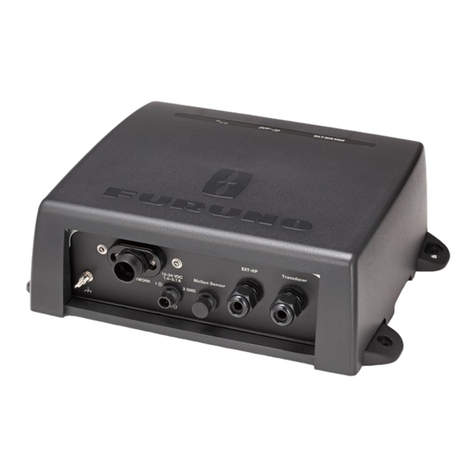
Furuno
Furuno DFF-3D Operator's manual
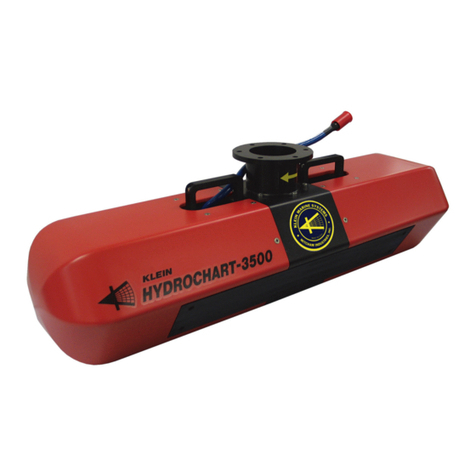
Klein Marine Systems, Inc.
Klein Marine Systems, Inc. HYDROCHART 3500 Operation and maintenance manual

Lowrance
Lowrance Hook Reveal X Series Operator's manual
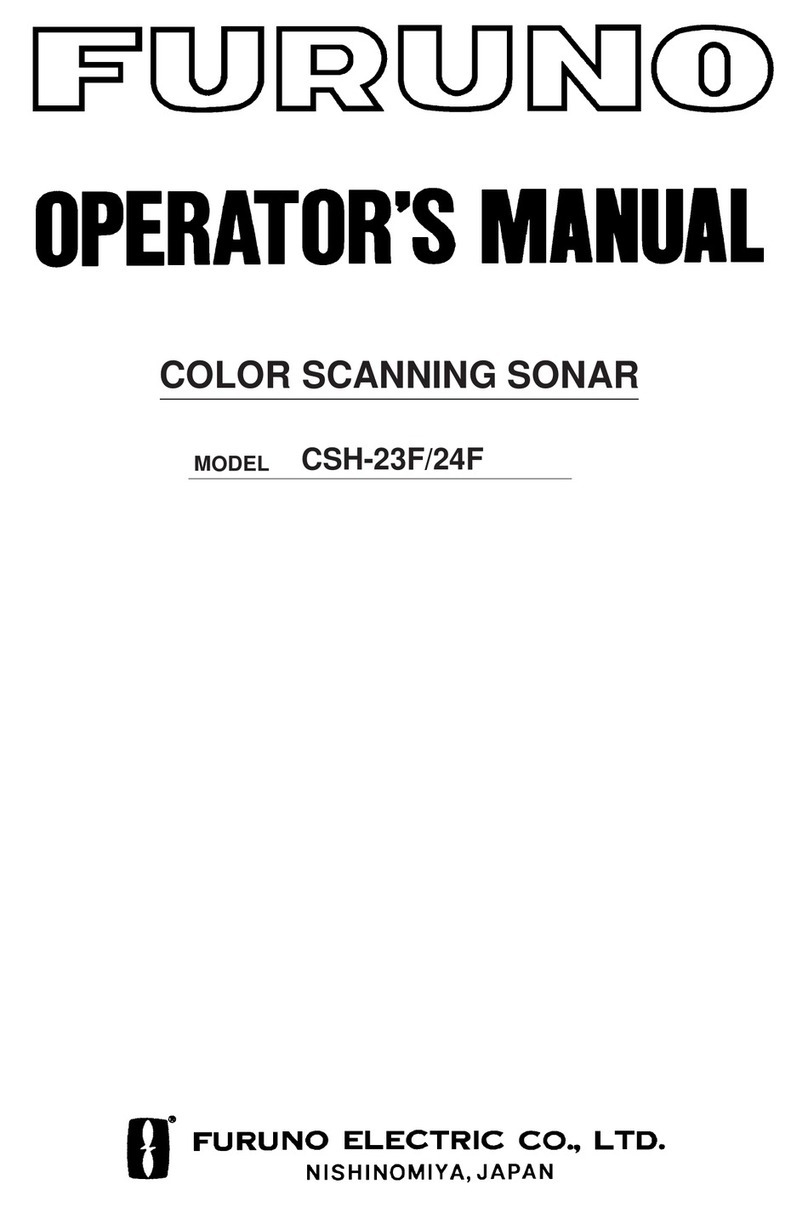
Furuno
Furuno CSH-23F Operator's manual

Furuno
Furuno CSH-5LMARK-2 installation manual
